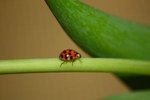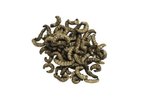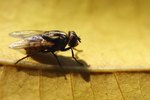Taxonomically speaking, maggots are larvae. The main difference between soldier fly larvae and maggots is that soldier fly larvae are the young of one species from the Orthorrhapha family of dipterid flies, and maggots are the young of several species from the Brachyceran family of dipterids. Functionally speaking, maggots are potentially dangerous pests, while soldier fly larvae are magical creatures from the land of super-gardening who can perform incredible feats of composting in record time.
Classy Heritage
Hermetia illucens is the black soldier fly. Young include several stages of voracious, omnivorous larvae and moving pupae that look like something out of a horror movie. Adults look like blue-black wasps, can be up to an inch long, and neither sting nor bite -- in fact, they don't even eat. They survive only a few days, long enough to breed and lay eggs. In contrast, many different flies have maggot young, some of whom are carnivorous and others, omnivorous. They're best known as carrion eaters, but several species will colonize living animals and can cause fatal infections. Though they play important ecological roles as decomposers, adults are universally known as pest insects. These include the houseflies, blowflies and bottleflies.
Looks Aren't Everything
Soldier fly larvae and maggots could hardly be more different. Only newly hatched solder fly larvae look remotely similar to the white, wriggling, limbless, soft-bodied maggots. Soldier fly larvae are flattened dorsoventrally, or top to bottom, and have singular hard cuticles. They're visibly segmented, with distinct heads. They are white at first, but they darken with age to blackish gray. After several molts they turn into nearly inch-long pupae that look headless and crawl around. They reach adult form up to 45 days from hatching, and are harmless and handleable the entire time -- unlike maggots, which can transmit disease and can burrow into living flesh, and unlike adult brachycerans, which often bite.
Work Ethic
Solider flies were once considered compost-dwelling pests to be controlled or eradicated, which is terribly sad for the gardener of yesteryear. Anyone who's dealt with old-style earthworm composting bins and pits is familiar with composting taking months. Soldier fly larvae can get the same job done in three days. They allow safe composting of meat scraps by eliminating them within hours, and love items like grain and citrus fruit, which in large quantities can kill earthworms or even create explosive gas. They cope well with high temperatures and low moisture. Moreover, they prevent potential house and carrion fly infestations around compost bins by out-competing maggots.
Triple Threat
When you have maggots, you pretty much just have maggots. When you have soldier fly larvae, you have a closed loop of a farming ecosystem: Soldier fly larvae can turn virtually any compost into nutrient-rich, wet, black sludge that plants love. Their piles of pupal casings are themselves high-quality fertilizer. Larvae and pupae are incredibly abundant -- some homesteaders use excess as poultry feed. They can compost animal waste and reduce swarms of pest insects around agricultural operations. Some farms use them to manage manure -- a significant environmental hazard when produced on the scale of factory farms. According to composting expert Cindy Wise of Oregon State University, these magical little superstars "consume up to 30 tons of hog manure in two days."
References
- BugGuide.net: Species Hermetia Illucens - Black Soldier Fly
- Oregon State University Extension Service: Big Maggots in Your Compost? They're Soldier Fly Larvae
- North Carolina State University Extension, Integrated Pest Management Program: Black Soldier Fly
- BSF Farming: Composting With Black Soldier Flies
- Texas A&M University Agrilife Extension: Soldier Fly
- Washington State University, Whatcom County Extension: Garden Friends & Foes
Resources
Writer Bio
Angela Libal began writing professionally in 2005. She has published several books, specializing in zoology and animal husbandry. Libal holds a degree in behavioral science: animal science from Moorpark College, a Bachelor of Arts from Sarah Lawrence College and is a graduate student in cryptozoology.





